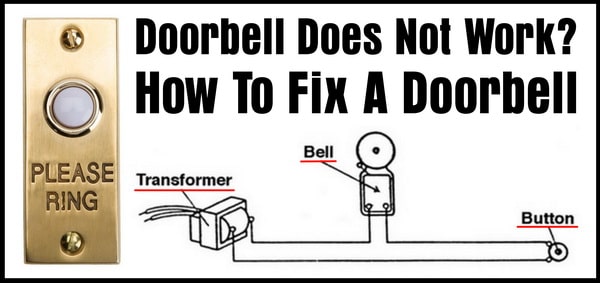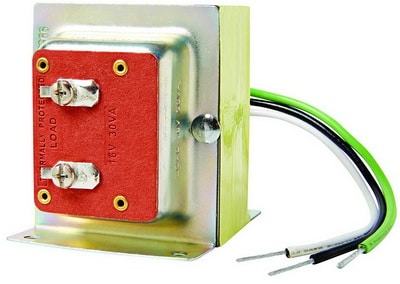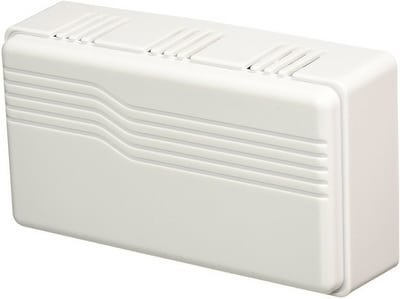QUESTION: My doorbell does not work. I do not hear the chime sound when I press the doorbell button outside. It makes a buzzing sound instead of the chime sound. What parts on a broken doorbell can cause it to make a buzzing noise and how do I fix my doorbell?
 How To Repair A Doorbell – Step By Step
How To Repair A Doorbell – Step By Step
WHAT CAUSES A BUZZING DOORBELL
A buzzing doorbell tells you the doorbell is not getting the proper voltage or the transformer has an issue. An average doorbell uses from 6 to 24 volts to work properly. Check the transformer if the doorbell is buzzing.
FIX A DOORBELL THAT DOES WORK
A doorbell that is not working can simply mean that the button is faulty. Twist the button to remove it and access the wires inside the doorbell button. Remove the 2 wires from the terminals with a screwdriver. Grab the 2 wires on the insulated area and touch the 2 wires together. If you hear the doorbell sound it means the doorbell button itself is faulty. Remove and replace the doorbell button. The button is not the issue? Read below for more helpful information to fix your doorbell.
BATTERY/ WIRELESS POWERED DOORBELL: If you have a battery powered doorbell that is wireless (not hard wired), try changing the battery. A wireless doorbell that uses battery power may make a buzzing or beeping noise when the battery is low. A wireless battery powered doorbell that is not working may need to be reset. Try turning the power button off for 5 minutes. Also try resetting the doorbell system by using the app that came with the doorbell.
HARD WIRED DOORBELL: If the doorbell is wired, your doorbell may have a bad terminal connection or frayed wires between the doorbell button, your home’s electrical system, the transformer, or the chime unit. Check the transformer, the button, and the chime. Remove and replace if any of these parts are found to be faulty. See below for more detailed information.
COMPONENTS IN A DOORBELL SYSTEM
A normal doorbell consists of 4 parts. The button outside your door, the wires to get power to the doorbell, the transformer that transforms the power to lower voltage, and the chime that makes the bell sound when the button is pressed.
 How Is A Doorbell Wired? – Doorbell Wiring Example
How Is A Doorbell Wired? – Doorbell Wiring Example
THE 4 PARTS IN A DOORBELL SYSTEM
- Doorbell button (creates the sound when button is pressed, completes the circuit)
- Wiring (brings the correct voltage to all parts of doorbell)
- Transformer (takes 110-120 voltage and reduces for doorbell)
- Chime unit (part of the doorbell that creates the “ding dong” sound)
HOW TO REPAIR A DOORBELL NOT WORKING
TEST THE DOORBELL BUTTON
Check the doorbell button to be sure it is working. Unscrew the doorbell, remove the plunger, and open the button. Remove the 2 wires from the terminals. Grab the wires on the insulated area and carefully touch the bare ends together. Do you hear the bell ring? If so this means the button is faulty and needs to be replaced. Research a new doorbell button here.
TEST THE DOORBELL WIRING
Inspect the wiring within the doorbell system. Check for any frayed and damaged wiring. If damaged or faulty wiring is found, rewire the system. Research bulk wiring here.
TEST THE DOORBELL CHIME UNIT
Locate the chime that makes the “ding dong” sound. Remove the cover on the chime and check for any wiring issues. Use a multimeter and check that the reading is in between 6 to 24 volts or whatever is written on the chime. If no voltage is present, check power input. If power is present, remove and replace the chime unit. (Be sure to have someone push the doorbell button while you check for voltage) Research a new doorbell chime unit here.
TEST THE TRANSFORMER
Locate the doorbell transformer, usually located near the doorbell chime, in a closet, in the attic, or underneath wall insulation. Inspect the transformer for any wiring issues. Confirm the transformer is getting (input) power. Test the transformer with a multimeter to make sure it is receiving the correct voltage which is 110 to 120 volts. Test again by checking the other terminals (output) to check for 6 to 24 volts going to the doorbell. If the multimeter check shows either below 6 volts or above 24 volts, the transformer is faulty and will need to be replaced. Research a new doorbell transformer here.
Easy Repair For Broken Doorbell
Need help with your doorbell? Please leave us a message below explaining the problem with your doorbell and we will investigate and reply back with helpful answers. We can help with all doorbell types including wireless, wired, video and camera doorbells, doorbell kits, ring, nutone, heath zenith, and more!





doorbell just hums, when pushing front switch nothing happens, 21.6 volts coming out of transformer, door chime becomes hot if left too long without disconnecting
Front doorbell press not consistently chiming in house.
1) switch front button press to rear door
= rear doorbell chimes the rear door single chime in house consistently
2) at chime box reverse front wire and rear wire so that the rear door would fail if the chime unit for front signal dead (solenoid valve or block?)
Result = rear door press consistently chimes the front 2-chimed sound in house correctly therefore it is not the chime box itself (?)
3) change transformer from 16v to 24 v = same issue and no change
4) confirmed with multimeter voltages at transformer and front press are correct
5) raw two wires at front press when connected chime in house the correct 2-chime and is consistent but once add to a press it fails in house chime
6) clean cut and stripped new wires for front press and at chime box
tested raw wires touching at press consistently chime in house correctly
7) confirmed all wires are secure to screws
8) at press with connections, multimeter indicates proper voltage but when pressed only the sound is consistent outside and a dud in house
What else could be the issue?
I replaced all the parts to my doorbell with chime are the transformer and the doorbell itself the chimer the wires coming out of the wall are frayed and they’re not color coded how do I know how to hook it up
Doorbell will just hum. I replaced chime, button, and transformer. Still just hums. I can’t imagine that the wiring went bad in the 20 years since new. Trying to fish wire through existing walls is a recipe for disaster. Is this really the next step?.
THANKS! JIM